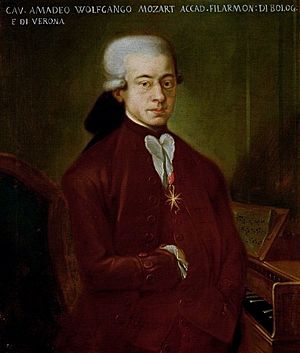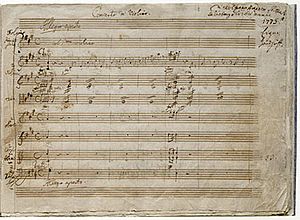Violin Concertos (Mozart) facts for kids
Wolfgang Amadeus Mozart was a super talented musician and composer from Austria. He lived a long time ago, from 1756 to 1791. During his life, he wrote many amazing pieces of music.
Among his works are at least five special pieces called violin concertos. He wrote these between 1773 and 1776 in Salzburg, Austria. He probably wrote them to play himself, as he was the concertmaster (the lead violinist) for the Archbishop of Salzburg's orchestra.
A violin concerto is like a musical conversation. It features a single violin player (the soloist) playing with a larger group of instruments, the orchestra. The soloist gets to show off their skills, while the orchestra supports them.
Contents
Mozart's Violin Concertos
Mozart's violin concertos each have three main parts, called movements. These movements usually have different speeds, or tempos, like fast, slow, and then fast again.
Violin Concerto No. 1 in B-flat major, K. 207
This concerto was written in Salzburg. It was composed on April 14, 1773 or 1775, but the exact year is not certain.
It uses a solo violin, two oboes, two horns, and string instruments. All three movements are written in a special musical structure called sonata form. This form was often used by composers for their more serious works.
- The first movement is Allegro moderato (a moderately fast speed).
- The second movement is Adagio (a slow and expressive speed).
- The third movement is Presto (a very fast speed).
Violin Concerto No. 2 in D major, K. 211
Mozart wrote this concerto in Salzburg on June 14, 1775. It also features a solo violin, two oboes, two horns, and strings.
It has three movements:
- Allegro moderato (moderately fast).
- Andante (a walking pace, a bit slower than Allegro).
- (Rondeau) Allegro (a fast movement with a main theme that keeps coming back).
Violin Concerto No. 3 in G major, "Strassburg", K. 216
This concerto was composed in Salzburg and is dated September 12, 1775. It's sometimes called "Strassburg."
Like the others, it uses a solo violin, two oboes, two horns, and strings. It has three movements:
- Allegro (fast).
- Adagio (slow and expressive).
- (Rondeau) Allegro (fast, with a returning theme).
Violin Concerto No. 4 in D major, K. 218
Mozart wrote this fourth concerto in D major in Salzburg in October 1775. The original handwritten music (called the autograph) is kept safe in the Biblioteka Jagiellońska in Kraków, Poland.
It has three movements:
- Allegro (fast).
- Andante cantabile (a singing, walking pace). This movement is known for its beautiful, expressive melody. It focuses on the feeling of the music rather than showing off how fast the violinist can play.
- Andante grazioso (a graceful, walking pace).
Violin Concerto No. 5 in A major, "Turkish", K. 219
This fifth concerto in A major is often called "Turkish." It was written in Salzburg and finished on December 20, 1775.
It uses a solo violin, two oboes, two horns, and strings. It also has three movements:
- Allegro aperto (a fast, open, and clear speed).
- Adagio (slow and expressive).
- (Rondeau) Tempo di Menuetto (a movement in the style of a minuet, a graceful dance).



